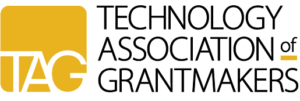Report from a Collaborative Design Studio
The Technology Association of Grantmakers (TAG), CAST Centre for the Acceleration of Social Technology, and Institute for Voluntary Action Research recently partnered to host a design studio in London. Twenty-seven leaders from philanthropy, nonprofits, and technology came together to build solutions around a bold provocation:
The form-based application process is broken. In the age of AI, how can we reimagine the way resources are distributed to the people, places, and organizations best placed to use them?
Generative AI is transforming how we access, create, and interact with information. AI adoption is happening fast—76% of charities report using AI in 2025, up from 61% just one year ago (2025 Charity Digital Skills Report). Similarly, 81% of staff at grantmaking organizations are experimenting with AI, even though two-thirds of funders still lack policies or governance frameworks (TAG State of Philanthropy Tech Report).
The opportunities are significant, yet the risks are equally real: reinforcing bias, increasing inequities, or placing technology ahead of people. In 2024, TAG’s research highlighted funders’ concerns: clarity in applications, quicker and more flexible processes, light-touch funding, and agreement on where human judgment remains essential. The success of CAST’s AI for Grantmakers network and IVAR’s research on an “Open and Trusting” approach to grantmaking reinforced that innovation should save time, strengthen relationships, and improve impact.
The Design Studio Approach
Unlike many AI discussions that focus on efficiency, this event asked participants to step back and rethink grantmaking from first principles.
Each group acted as a new grantmaker with £50 million to distribute, free from legacy systems. They were asked to design a funding process combining human insight with AI. Teams captured what they knew, what they thought they knew, and what they needed to know, creating a collective knowledge map to guide prototypes. Groups then developed and presented ideas, producing diverse solutions.
Five Key Themes
Several themes consistently emerged from the studio’s discussions and prototypes:
1. AI is not a silver bullet. While powerful, AI cannot fix systemic inequities in funding. Without human-centered design, technology risks deepening flaws in current processes.
2. Collaboration unlocks value. The most effective solutions arose when funders, technologists, and practitioners worked together. As TAG’s Jean Westrick observed, “technological advancements only deliver genuine value when they serve human needs and are developed within a community context.”
3. Responsible adoption is essential. Just as cars needed seatbelts and traffic laws, AI requires guardrails—policies, standards, and governance—to build trust and enable safe scaling.
4. Experimentation drives progress. Prototyping and iteration are vital. Funders play a crucial role in supporting safe spaces where new ideas can be tested before being scaled.
4. The challenges are global. Issues surfaced in London mirror those in the US and elsewhere, underscoring the need for international collaboration and shared learning.
From the day’s design work, a few priorities became clear. First, funders need a shared, data-informed view of what makes an applicant “fundable.” Second, finding qualified applicants requires proactive outreach. While AI can help map landscapes, human engagement is what ensures under-represented organizations are discovered and supported. Also, a shift from a compliance-driven approach to trust-based, learning-oriented relationships is needed to foster innovation and reduce risk aversion. Ultimately, whole-systems thinking is needed. Governance, security, data, skills, and workflow must be considered together, even when piloting small innovations.
What We Learned
The five teams produced tangible concepts for applying AI to grantmaking, showing both creative uses and boundaries where human judgment remains paramount. Participants moved from tentative steps to visible enthusiasm, reinforcing the value of convening diverse voices. Lessons from the session were applied in real time—for example, Emma Kirby of the National Lottery Community Fund took ideas from the studio straight to her board. In the end, the day confirmed the need for convenings that bring funders, nonprofits, and technologists together. These spaces for collaboration are as critical to fund as the technologies themselves.
By staying human-centered, responsible, and collaborative, we can harness AI to make grantmaking more inclusive, equitable, and impactful. The work has only just begun, but one message is clear: we solve the big problems best when we solve them together.For a more detailed look at the design studio’s work and outcomes, please read the full report from TAG, CAST, and IVAR.
